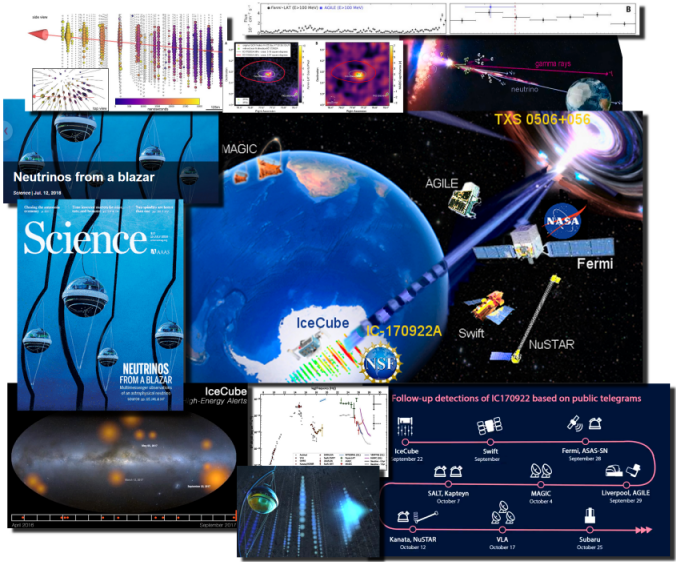Neutrinos, electrically uncharged and traveling at nearly the speed of light, are able to escape the densest astrophysical environments and point back to their source of origin, therefore they represent unique tracers of cosmic-ray particles acceleration. Such extreme environments can be found in blazars, that are active galactic nuclei characterized by accreting supermassive black holes developing immense relativistic jets of plasma pointing close to our line of sight. Blazars are among the most powerful objects in the universe speculated to be sources of high-energy cosmic rays.
The discovery of an association of a very high-energy neutrino with a flaring photon gamma-ray blazar object by the IceCube experiment and the Fermi space satellite, announced on July 12, 2018 with a press conference by NSF and a cover and paper in the Science journal, highlights for the first time mechanisms and conditions for highest-energy cosmic rays acceleration and the existence of extragalactic sources producing high-energy neutrinos and gamma rays. The detection of an about 290 TeV energy neutrino (namely the event IC-170922A) on 22 September 2017 by the IceCube experiment at the Amundsen-Scott South Pole Station, in Antarctica, was found to be consistent with the location of a Fermi Gamma-ray Space Telescope catalogued gamma-ray source (3FGL J0509.4+0541, i.e. the blazar TXS 0506+056). The Fermi Large Area Telescope (LAT) first reported the positional coincidence (within 0.1 degrees) of the very high-energy neutrino event with a gamma-ray source detected at E>100 MeV, the blazar TXS 0506+056 (also known as MG1 J050927+0541, RX J0509.3+054, ZS 0506+056 and other), in a flaring state, issuing one Astronomer’s Telegram (ATel) on September, 28, 2017.
This triggered many observations and results with the corresponding multi-wavelength follow-up measurements, for example by MAGIC, AGILE, Swift and NuSTAR. All these are missions and experiments see the participation of the ASI Space Science Data Center (SSDC), and Fermi, MAGIC and AGILE are built with a fundamental contribution of INFN and INAF. Notably AGILE confirmed soon after the association of IC-170922A with the E>100 MeV gamma-ray activity of TXS 0506+056 with another ATel, while the MAGIC Cherenkov telescope also detected it and revealed periods where the gamma-ray flux from the blazar reached energies of up to 400 GeV. Subsequent measurements of the source have been completed at X-ray, optical, and radio wavelengths. Formerly AGILE suggested also a possible association of gamma rays with an IceCube neutrino event in July 2016, after the detection of a gamma-ray transient found to be consistent with the position and time of IC-160731.
Based on the redshift of TXS 0506+056, with value z=0.3365 corresponding to a luminosity distance of 5.5 billion light years, accurately measured and published in February 2018 (only upper/lower limits were available before), constraints are derived for the muon neutrino luminosity for this source, found to be similar to the luminosity observed in gamma rays. The energies of the gamma rays and the neutrino indicate that blazar jets may accelerate cosmic rays to at least several PeV. Chance correlation of this neutrino with the flare of TXS 0506+056 is statistically disfavored at the level of 3 sigma in any of the evaluated models associating neutrino and gamma-ray production. This important result for the newborn multi-messenger astro-particle physics confirms the close relations among the different cosmic messengers. The most extreme cosmic explosions producing transient gamma rays (GRBs) also produce gravitational waves, and the most extreme cosmic accelerators producing intense, persisting and variable flux of gamma-rays (blazars) produce high-energy neutrinos and cosmic rays.
Through the Fermi and AGILE satellites and the large ground based astro-particle experiments for neutrinos, UHE cosmic rays and gravitational waves, gamma rays are providing a bridge to each of these new cosmic signals, opening the multi-messenger astronomy era. Many interpretations and works, published or in preparation, are following up the discovery, shedding light on a truly multi-messenger scenario for the flaring GeV gamma-ray blazar TXS 0506+056 and the implications for very high-energy neutrino emission and cosmic ray acceleration. The ASI SSDC is contributing and supporting archive, data, software and science operations and data analysis tasks for the Fermi, AGILE, Swift, and NuSTAR missions.
More information:
Italian news:
Figure collage credits: SCIENCE magazine/American Association for the Advancement of Science (AAAS), SCIENCE Communication Lab, IceCube Collaboration, NSF U.S. National Science Foundation-Office of Polar Programs, NSF U.S. National Science Foundation-Physics Division, University of Wisconsin-Madison, National Aeronautics and Space Administration (NASA), NASA’s Goddard Space Flight Center/CI Lab, NASA/DOE/Fermi Large Area Telescope Collaboration, Sonoma State University, MAGIC Collaboration, AGILE Collaboration, PGC/NASA U.S. Geological Survy Data SIO,NOAA, U.S. Navy, NGA, GEBCO Landsat/Copernicus, Jamie Yang, Savannah Guthrie, Nicolle R. Fuller, Aurore Simonnet.
